#john d. payne
Text
SoR/LotR: “Adrift” [S01E02].
Serie: Sagan om ringen: Maktens ringar.
Originaltitel: The Lord of the Rings: The Rings of Power.
Skapare: John D. Payne.
Författare: J.R.R. Tolkien (boken).
Författare: Gennifer Hutchison (avsnittet).
Regissör: Juan Antonio Bayona (avsnittet).
Publicerad: 2022.
Medium: TV/Prime Video.
¡Oi! Spoilers, stavfel och alternativa fakta kan förekomma rakt föröver!
Ses tillsammans med @kulturdasset.

Berättandet börjar komma i gång, men känns fortfarande lite avslaget. Kanske är det jag som inte riktigt nås av den här delen av storyn? En hel del intressant kommer igång iaf, lite nyfiken är man på vad det är som vaknat i Harfoot-lägret, är det Sauron?
Scenerna ombord på flotten vet jag inte hur jag skall ställa mig till, än så länge vet jag inte om de tillfört så mycket mer än introducera oss till ännu en karaktär. En karaktär som kommer bli vital för Galadriels fortsätta äventyr/kamp mot ondskan verkar det som. Appropå ondska, kanske kan jag tycka att det hela utvecklingen är lite för abrupt här. Kungen ”belönar” Galadriel och hennes skvadron med att förvisa dem västerut, och i och med det så börjar orcer och allehanda ondskligheter röra på sig. Nog för att vi alla tenderar att se vad vi vill se (här Alvkungen att onskan är död, och Galadriel att den är närmare än någonsin sedan kriget) men är det kanske så att kungens envisa kungörelse att kriget låter hinta om att kungen kanske spelar för ett annat lag än det han förmodas spela för?
Scenerna med Durin är hur som helst något av avsnittets guldkorn. Gillar samspelet mellan Durin och hans fru och hur den sistnämnda går in och medlar för att läka vänskapen mellan Durin och Elrond. Appropå Elrond är jag lite nyfiken om det är just ringarna som han och Celebrimbor preppar för nu? Prinsessan Disas förklaring om när de sjunger för stenen fick mig att tänka på Sagan om Drakens Återkomst och ”sjunget trä”. Men det är ju allmänt känt att Robert Jordan inspirerades en hel del av just Sagan om Ringen.
Jag är fortfarande inte helt övertygad.
Jag skulle säga att det tar sig, men berättandet hoppar lite för mycket för sitt eget bästa. Det är inte så att jag har problem med att hänga med, utan alla dessa hopp blir frustrerande i längden. Lite som jag minns när jag läste Kampen om Järntronen[1] när det begav sig, man dröjer inte så länge vid karaktärerna att man hinner bry sig om dem.
Fotnoter.
Jag har bara läst första boken i George R. R. Martins fantasy-epos ”Sagan om Is och Eld”, första boken var uppdelad i två delar varvid andra delen hette ”Vargens Tid” och tillhör de sämre läsupplevelserna inom genren. Mina utgåvor är f.ö. daterade 1996 & 1997 och lästes däromkring.
#tv#streaming#John D. Payne#J.R.R. Tolkien#Gennifer Hutchison#Juan Antonio Bayona#Sagan om ringen: Maktens ringar#The Lord of the Rings: The Rings of Power#s01e02 Adrift#fantasy#äventyr#action#Prime Video#2022#US
29 notes
·
View notes
Photo





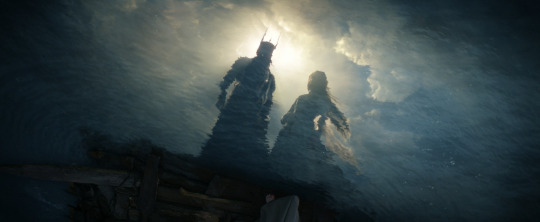


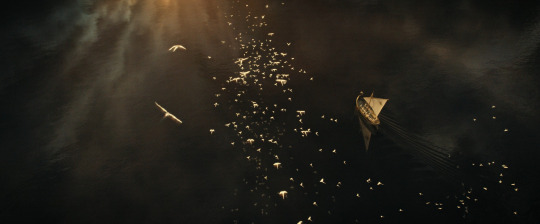
the lord of the rings: the rings of power (patrick mckay & john d. payne, 2022)
#lotr#the lord of the rings: the rings of power#patrick mckay#john d. payne#wayne yip#j.a. bayona#charlotte brändström#aaron morton#alex disenhof#oscar faura#s
22 notes
·
View notes
Text
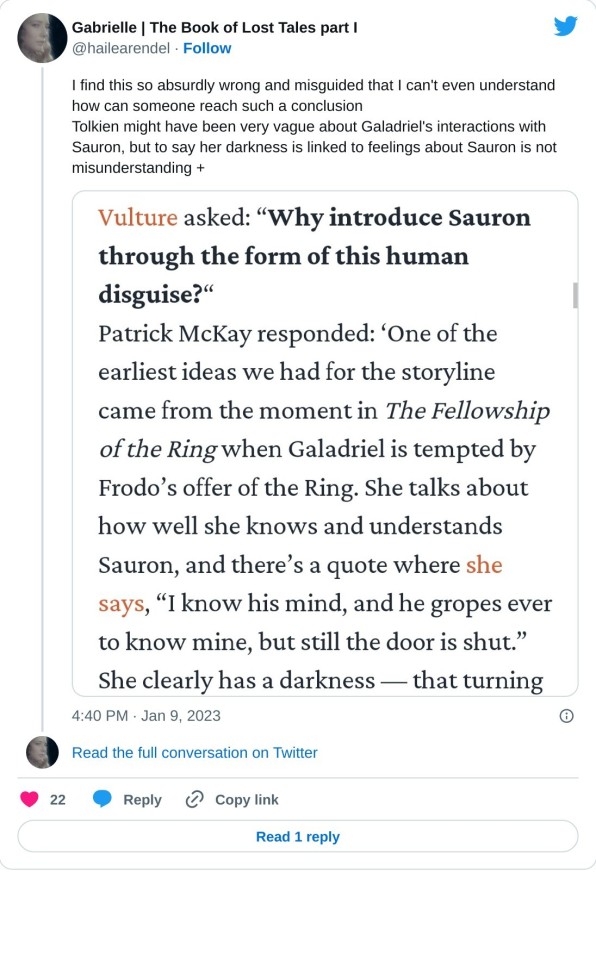

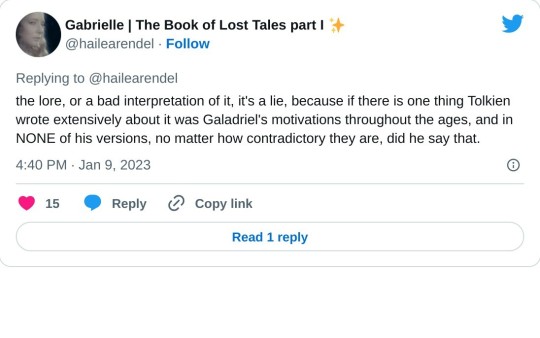

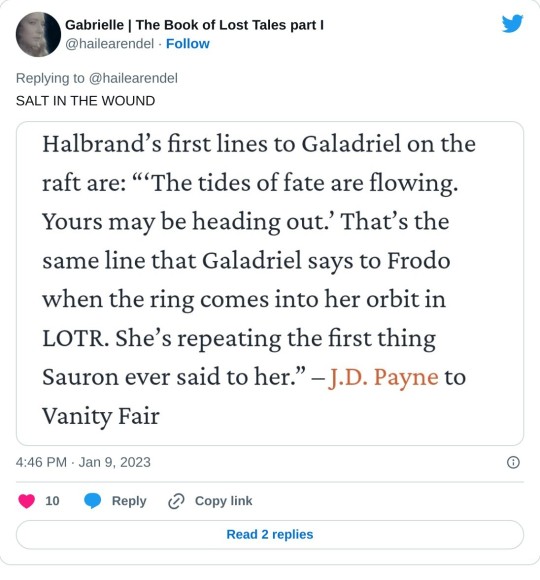
#the rings of power#john d. payne#patrick mckay#galadriel#sauron#every time they they talk about Sauron and Galadriel it's a disaster#i really don't get who they are trying to convince this mess makes sense#the fangirls will fangirl whatever you throw at them as long they get to fantasize about a good heroine being corrupted by a dark lord#but the tolkien fans who gather on the unique subreddit that doesn't trash the show will start to look down on the show with such takes#it's not even the showrunners' idea#i'm 100% sure that this absurd and insane move comes from gennifer hutchinson the writer of adrift and alloyed#based on her interviews i really wonder if she has read one line written by tolkien#she looks like someone who only worked based on the summaries of the story made for her by the real experts#and this crazy pic she posted of the two funko pops of galadriel and sauron!#the level of embarrassment!#what is she? a 5year old playing with her barbie and dark ken dolls?#i love this show with all my heart but someone please should fire her and fire payne and mckay with her#and i'm saying that as someone who was very supportive of her presence in the writing team at first#i was impressed and used extensively her achievements on breaking bad/better call saul and emmy's nominations to defend the writing quality
5 notes
·
View notes
Text
Rings of Power s1ep3
are you ready? pick up your feet and let's go! the journey in middle earth continues. Can you handle it?
come check out the third episode review!
episode name: adarwritten on: 16-09-2022actors: morfydd clark, lioyd owen, charlie vickers, markella kavenagh, ismael cruz cordovastudio: prime videodirector: wayne yipwriter: john d payne, patrick mckay, j.r.r tolkien——————————–personal rating:★★☆☆☆tomatometer:episode rating:critics: 86% (7.2/10)ratings: 22season ratingcritics: 82% (7.2/10) |▼84%||▼8.0/10|ratings: 310audience: 39% (4.8/10) |►…
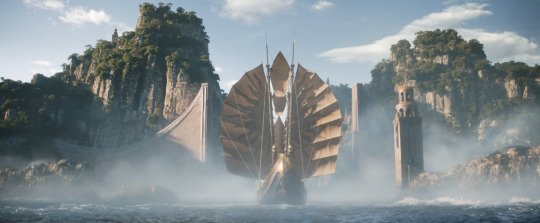
View On WordPress
#2 stars#2022#acteurlover#adar#charlie vickers#episode 3#ismael cruz cordova#j.r.r tolkien#john d. payne#lioyd owen#markella kavenagh#morfydd clark#patrick mckay#prime#review#Rings of Power#season 1#tv-show#wayne yip
0 notes
Text
When Will We See The Rings of Power? The Challenge With LotR on Streaming.
@edohotep shares his thoughts on #LotR #TheRingsofPower after giving it multiple watches, since one view is never enough! #fantasy #streaming #amazonprime
Spoiler Alert
The only issue I have with Amazon committing to bring more Lord of the Rings to life concerns what parts of J. R. R. Tolkien’s appendices are key to the shaping of The Rings of Power? I appreciate the fact the X-Ray feature links to additional material to help folks understand the source, and if its supposed to segway to the films, its not teasing at anything yet!
This multimedia…

View On WordPress
#Amazon Prime#Fantasy#J.R.R. Tolkien#John D. Payne#Lord of the Rings#Morfydd Clark#Patrick McKay#Rings of Power#Robert Aramayo#Spoiler Alert
0 notes
Text
Lord Of The Rings: The Rings of Power. Global Fan Screening ( Episodes 1-2.) Review/ Impressions
More TV on the big screen please
We have arrived at a point in 2022 web blockbuster TV has so thoroughly eclipsed film as the avenue for truly immersive huge budget storytelling. The best of this material put a chunk of what is regularly on the big screen to shame. The antithesis of this ( certainly from a budget and scale perspective) is the arrival of amazons megabudget attempt to bring the Lord of the Rings to serialized…
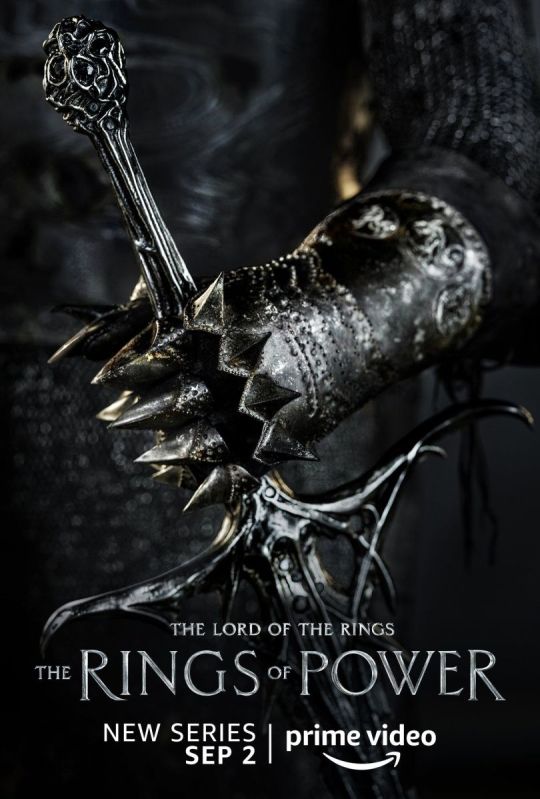
View On WordPress
#Charles Edwards#Daniel Weyman#Dylan Smith#Ismael Cruz Cordova#J.R.R. Tolkien#John D. Payne#Lenny Henry#Markella Kavenagh#Maxine Cunliffe#Megan Richards#Morfydd Clark#Nazanin Boniadi#Patrick McKay#Peter Tait#Robert Aramayo#Sara Zwangobani#Thusitha Jayasundera#Tyroe Muhafidin
0 notes
Text

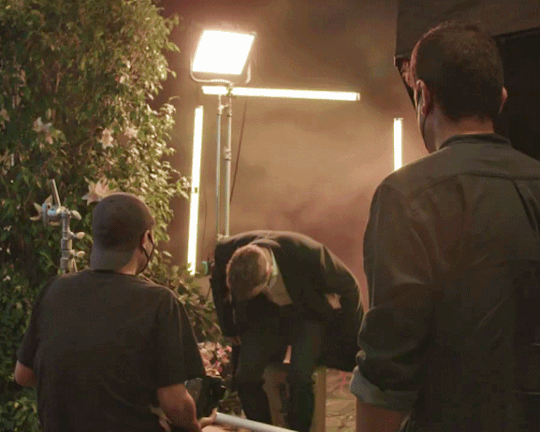
"This is YOUR world. You're playing Sauron." 👑
#charlie vickers#halbrand#sauron#the lord of the rings: the rings of power#the rings of power#rings of power#the lord of the rings#trop#Trop showrunners#Patrick mckay#John d payne#This is his world we are just living in it
27 notes
·
View notes
Text
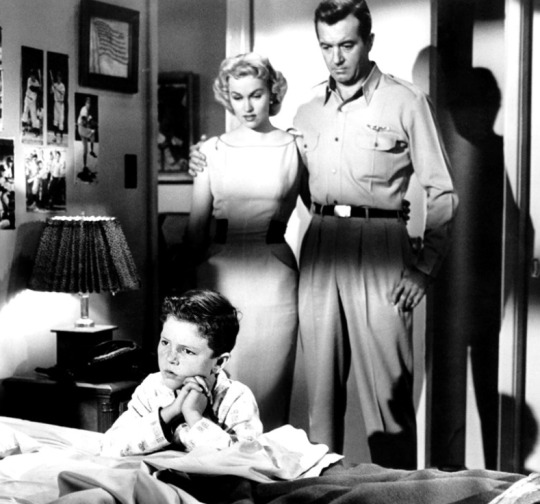
Richard Eyer-Karen Steele-John Payne "Bailout at 43,000" 1957, de Francis D. Lyon.
4 notes
·
View notes
Text
For all my fellow name nerds out there, I am very pleased to present the second annual "Gloyd Roberson Memorial List of Actual Human Children Who Wrote Letters to Santa in 1920s/30s Oklahoma".
These aren’t all necessarily “weirder than Gloyd” but fall into three rough categories which I’ve dubbed: “that’s got a nice ring to it”, “if I used this in a novel it would be considered too unrealistic” and “you’ve got 5 seconds to name a character that lives in 1920s Oklahoma, GO!”:
Selvyn Atteberry
Dyer Banfield
Bert Baxter
Hilda Bender
Imogene Berry
Heloise Blakely
Burl Boyer
Clyda Pearl Boyington
Okal Brooks
Vada Jo Bricker
Deverett Brumley
Lee Roy Buck
Vivian May Burdue
Donnie Buster
Elmarie Button
Junior Buzzard
Melchor Caldex
Tycene Calhoun
Tiny Bell Callison
Dapalene Caywood
Edney Clopton
Buster Combs
Georgia Countryman
Vantruba Crockett
Alto Day
Buddie DeWayne
Violet Divine
Elwanda Downing
Cletys Durham
Thurlo Epps
Apple Fields
Floyd Fleetwood
Metherine Franklin
Ula Fay French
Wanda Jo Fronterhouse
Irline Fuller
Jack Gritzmaker
J. D. Grizzle
Billie Jean Gulley
Joline Hardcastle
Kaloolah Herrill
Thelias Hatfield
Elva Heavins
Coleman Hewlett
Helen Hillhouse
Virgil Holderby
Katymae Houston
Myree Huffstutlar
Estelline Hurrypack
Blondie Huhm
Lila Lou Jackson
Denver Jones
Vernell Lambert
Sonny Boy Lockart
Dinkey Long (autocorrect really wanted this to be Donkey Kong)
Bamma Lynn
Rep Madden
Standford Mann
Jack Mattingly
Goldia McGee
Madge Messinger
Mauzell Mullins
Jeffie Wayne Muskrat
Archibald Neighbors
Hazel Nickerson
Eulah Oakley
Lyle Oyler
Milburn Partain
Jackson Payne
Montana Phillips
Bobbie Dean Phoenix
Toots Putman
Madonna Mae Rickey
Cyprine Robertson
Juanelle Schneeberger
Billie Jean Sparks
Texanna Smith
Pansy Stetson
Patsy Ruth Stubblefield
Eldon Sweezy
Hoy Trotter
Pearl Vandorien
Leland Weems
Joe Bob West
Wayness Whitely
Buster Wyatt
John Ira Youngblood
Domby Zinn
#feel free to use for any western themed dnd campaigns#or dust bowl romance novels you may be writing#names#oklahoma#1920s#1930s#dnd#long post
1K notes
·
View notes
Text
happy Masters of the Air release week. In honour of the series due to release on the 26th, I wanted to list a few faces we’ll be seeing throughout the series. I want to particularly note the crewmen of the 100th in hopes this makes sense to viewers who either a) didn’t have time to read any books based on the 100th bomb group, or b) want to read Masters of the Air by Donald L. Miller during/after the tv show aires. My lovely friend on tumblr @kylaym was happy to message me on instagram regarding who’s who for most of the 100th bomb group posts. She gets that everyone in uniform looks the same; same haircut, moustaches, masks, everywhere, etc. She mentioned it is always better to remember a bunch of lads as groups and crews than as individuals!
Here we gooo..
Colonel Neil “Chick” Harding
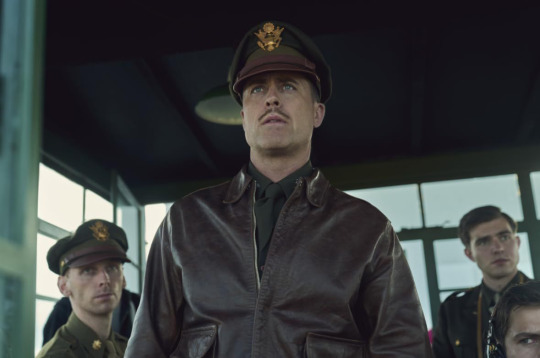
A West Point graduate and the school’s football coach prior to the war. Harding was a seasoned aviator who truly emulated much of the 100th’s attitude. He exhibited an appreciation for his crew’s mental and emotional well-being.
Major John C. “Bucky” Egan and Major Gale “Buck” Cleven
Two of the squadron commanders, Majors John “Bucky” Egan of the 418th Bomb Squadron and Gale “Buck” Cleven of the 350th, had piloting skills which matched their personalities. (Found top row 3rd and 4th members from left to right).

Captain John D. Brady
He served as a pilot in the 418th bomb squadron and was shot down during the mission to Munster on October 10th, 1943. (Shown here on the far left). He flew overseas in A/C #42-30071 “Skipper” as 1st Lt. Pilot. 2nd Lt’s being Lt. John L. Hoerr [Co-Pilot] and Lt. Harry Crosby [Group Navigator and Captain].
M/Sgt. Kenneth A. Lemmons
He served on the 351st Bomb Squadron and was one of the first crew chiefs assigned to the 100th Bomb Group. After being a part of the U.S. Air Force's ground crew, he was subsequently promoted to the position of flight chief. (Shown above in the front).
Harry H. Crosby
Harry served as a navigator in the 418th Bomb Squadron and later became Group Navigator for the Hundredth, however, his struggle with airsickness often hindered his ability to navigate. (Found above beside Brady on the right). Harry Crosby replaced Lt. Payne on the crew of Douglass.

Payne is found above on the right, beside Harry Crosby.
Lt. Howard B. “Hambone” Hamilton
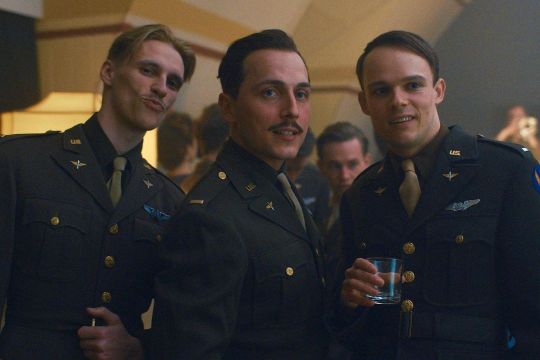
He was a bombardier mostly known for flying with Brady’s crew.
On the October 10th Munster mission, crew #32 was led by Major John C. Egan as Co-Pilot. Near the initial point “Mlle Zig Zig” was hit by Flak, resulting in the following:
- Sgt Clanton passing away
- wounding Howard Hamilton and Roland Gangwer. (Both ended up spending a long time in the hospital).
- the surviving crew members bailed out but were taken prisoner.
Hamilton is seen above on the far left. Beside him on the left is Lt. James Douglass and Captain Frank Murphy.
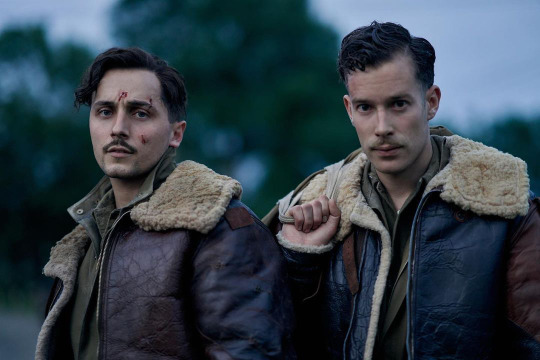
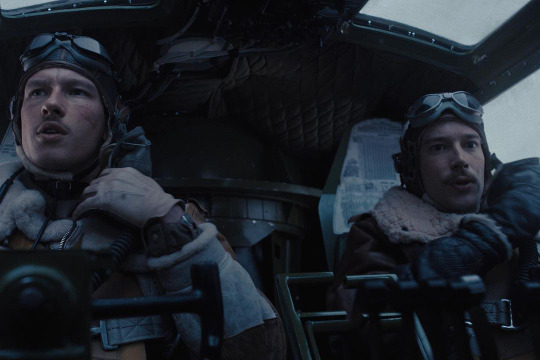
Captain James Douglass
Served as a bombardier in the 418th Bomb Squadron with the Everett Blakely crew. (Seen above in the first picture beside Blakely).
Major Everett E. Blakely
Was a career officer of the United States Air Force. He was a highly decorated pilot of the B-17 bomber with the Bloody Hundredth Bombardment Group of the 8th Air Force. He is most commonly known for his crew’s plane “Just a Snappin”. On a mission to Bremen on October 8th, 1943, his plane was severely damaged by flak and enemy fighters. He later became the Group Training Officer (Shown above on the right and next to Major John Egan in the second picture above).
Blakely’s Crew:
Major John Kidd- Command Pilot
1st Lt. Everett Blakely- Pilot
2nd Lt. Charles Via- Formation Officer in the tail (SWA on the mission during Black Week)
1st Lt. Harry Crosby - Navigator
2nd Lt. James Douglass - Bombadier
T/Sgt. Edmund Forkner - Radio operator
S/Sgt. William McClelland - Ball Turret Gunner (WIA on the Black Week mission)
S/Sgt. Edward Yevich - Waist Gunner (WIA on the Black Week mission)
S/Sgt. Lyle Nord - Waist Gunner
S/Sgt. Lester Saunders - Tail Gunner (KIA on the Black Week mission)
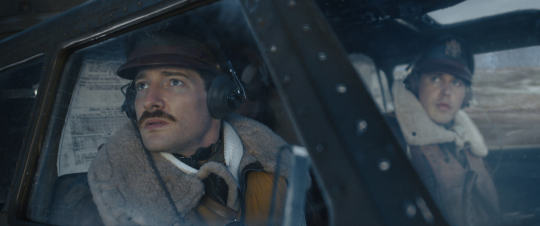
Lt Roy Claytor
Roy Claytor was part of the 350th Squadron. Above, he may be flying as a command pilot in this mission or practice with the Claytor Crew.
He is seen above on the left, beside Cleven.
Major Robert 'Rosie' Rosenthal
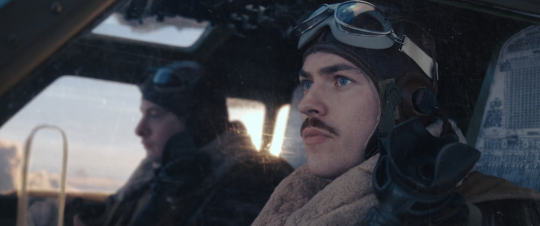
Rosie joins the unit in late 1943. He becomes one of the 100th's most reliable pilots.

Rosenthal's Crew:
[Shown left to right; top row than bottom row]
Sgt. Loren Darling - Waist Gunner
Sgt. Michael V. Boccuzzi - Radio Operator/Gunner
Sgt. John H. Shaffer - Waist Gunner
Sgt. Clarence C. Hall - Top turret gunner/engineer
Sgt. William J. DeBlasio - Tail Gunner
Sgt. Ray H. Robinson - Ball Turret Gunner
Lt. Ronald C. Bailey - Navigator
Lt. Robert 'Rosie' Rosenthal - Pilot
Lt. Clifford J. Milburn - Bombardier
Lt. Winifred 'Pappy' Lewis - Copilot
Lt. Curtis Biddick

Lieutenant Curtis Biddick was known as a ‘hard luck’ pilot but was recognised as exceptionally expert and courageous. ‘Every time he went out something seemed to happen,’ said one of his buddies. On one raid he brought his plane back with 1,700 shell and bullet holes in it and two wounded men aboard.
He clashes due to his English colleagues embarking on night-time raids.
Richard Snyder
Biddick's co-pilot and was part of the 418th Bombardment Squadron.
Okay.... So I truly hope this helps going into Masters of the Air tomorrow. I can't wait to see all the bomber boys spread their wings and fly. This tv series is going to be an absolute wreck (in the best way possible). Thank you to everyone who enjoys my posts. Love y'all.
#hbo war#masters of the air#austin butler major gale buck cleven#austin butler masters of the air#callum turner#john egan#barry keoghan#@mads-weasley
89 notes
·
View notes
Text
SoR/LotR: “Alloyed” [S01E08].
Serie: Sagan om ringen: Maktens ringar
Originaltitel: The Lord of the Rings: The Rings of Power.
Skapare: John D. Payne.
Författare: J.R.R. Tolkien (boken).
Författare: Gennifer Hutchison & John D. Payne & Patrick McKay (avsnittet).
Regissör: Wayne Yip (avsnittet).
Publicerad: 2022.
Medium: TV/Prime Video.
¡Oi! Spoilers, stavfel och alternativa fakta kan förekomma rakt föröver!

Så kom den så då till slut: seriefinalen. Och kanske är det här det bästa avsnittet i hela säsongen… Så lagom nu att bli intressant. Eller: nej jag överdriver en aning.
Man inleder med att försöka lura tittaren att alla spekulationer att meteoritmannen är Gandalf är fel. Det är det givetvis inte, men det är lite kuligt att se när Hårfotingarna lyckas befria meteoritmannen och de androgyna varelserna inser att de inte fått tag på sin store mästare.
Jag skall erkänna att även om jag var misstänksam mot Helbrand (som om han ständigt höll något hemligt) så var det lite av en överraskning att han var Sauron. Jag kan bara utgå från att han genomgick samma minnesförvirring som Meteoritmannen, och att han under en tid kanske till och med trodde han var söderns återvändande konung. (Och typ, det var han – men inte på det viset Galadriel väntade sig).
Överlevande från Númenor återvänder till ett land i sorg då den gamle kungen lämnat in. Det sista han säger är någon yrande profetia om att landet kommer gå under om de inte återvänder till de gamla sederna. Och minns jag inte fel så gick väl landet under? Visionerna Galadriel hade i Palantír:en visade att en tsunami sveper in över landet – något som då påminde mig om legenderna om Atlantis. Det känns som om serien inte är klar med folket från Númenor än.
Han har inte haft många scener i säsongen med alvernas högste kung är verkligen en karaktär, direkt otrevlig i de flesta av sina scener och jag börjar misstänka att det kanske finns mer än bara rent mjöl i hans påse. Själva smidandet av de tre ringarna är sällsamt odramatiskt. Men gillar att vi får reda på varför de tre ringarna ursprungligen smiddes.
Det här har varit en lång och tung säsong, där det varit svårt att se fram emot varje avsnitt. Berättarglädjen har helt enkelt inte funnits där, och Daniel Roman på WinterIsComing.com kanske sammanfattar serien bäst:
For my money, The Wheel of Time stands head and shoulders above The Rings of Power in this regard; in fact, I’d say that writing is The Rings of Power’s single biggest weakness, which is a dangerous fatal flaw for a show to have. It looks gorgeous, has solid actors and a beautiful musical score. But its first season has consistently felt like it was moving down a list of bulleted plot points, rather than diving deep into its characters and getting viewers invested the way great shows do. (Källa: winteriscoming.net)
Och jag håller med i mycket av vad han säger berättandet var en sammanställd checklista och berättarkonsten låg att dra på det i åtta avsnitt. Och allt förpackat med effekter, skådespelare och musik som berättandet egentligen inte förtjänade. Och då nämner jag ändå inte hoppen. Halva säsongen spenderades med maniskt hoppa runt mellan karaktärerna med samma snabbhet och grace som Sanna Kallur på 100m häck. Ingen tid spenderades, som citatet ovan säger, med att låta oss lära känna karaktärerna.
Avsnitten har kanske varit i det längsta laget de med, dock så noterar jag med humor att avsnitten till den tredje säsongen av The Orville varit bitvis längre (längsta klockade in på 1h:27min) men där märktes längden inte av alls. Det är en konst att berätta bra och engagerande – Amazon har med LotR:RoP och WoT visat att budget är inte allt.
Jag avrundar med att tacka @kulturdasset för sällskapet igenom den här säsongen. "Delad glädje är dubbel glädje, delad börda är halv börda" som man brukar säga.
P.S. Regissören till det här avsnittet regisserade även ett par avsnitt av WoT, kanske därför det tillhör ett av de bättre?
Länkar.
The Wheel of Time should’ve gotten The Rings of Power’s huge budget.
#tv#streaming#john d. payne#j.r.r. tolkien#gennifer hutchison#patrick mckay#wayne yip#sagan om ringen: maktens ringar#the lord of the rings: the rings of power#alloyed#s01e08 alloyed#fantasy#äventyr#action#prime video#2022#us
25 notes
·
View notes
Text
THIS DAY IN GAY HISTORY
based on: The White Crane Institute's 'Gay Wisdom', Gay Birthdays, Gay For Today, Famous GLBT, glbt-Gay Encylopedia, Today in Gay History, Wikipedia, and more … December 16

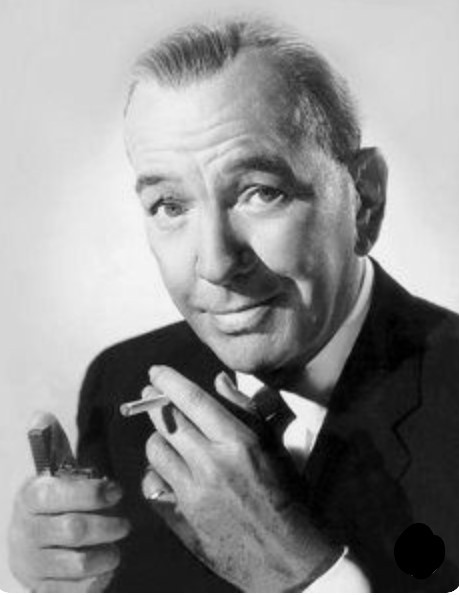
1899 – The English actor, playwright, and composer Noël Coward was born on this date (d.1973). Among his achievements, he received an Academy Certificate of Merit at the 1943 Academy Awards for "outstanding production achievement for his film In Which We Serve."
He was a valued friend of Laurence Olivier, Vivien Leigh, John Mills, Gene Tierney, Judy Garland, Elaine Stritch, Princess Margaret and Queen Elizabeth the Queen Mother. He was a close friend of Ivor Novello and Winston Churchill.
Coward was Gay and never married, but he maintained close personal friendships with many women. These included actress and author Esmé Wynne-Tyson, his first collaborator and constant correspondent; the designer and lifelong friend Gladys Calthrop; secretary and close confidante Lorn Loraine; his muse, the gifted musical actress Gertrude Lawrence; actress Joyce Carey; compatriot of his middle period, the light comedy actress Judy Campbell; and (in the words of Cole Lesley) 'his loyal and lifelong amitié amoureuse', film star Marlene Dietrich. Coward refused to acknowledge his sexual orientation, wryly stating, "There is still a woman in Paddington Square who wants to marry me, and I don't want to disappoint her."
Coward's insights into the class system can be traced back to London life in World War I, when thousands of troops passed through the capital every day, and officers and other ranks met civilians in dozens of highly secret clubs.
He enjoyed a thirty-year relationship with the stage and film actor Graham Payn from the mid 40s until Coward's death. Payn later co-edited with Sheridan Morley the collection of his diaries, published in 1982. He was also connected to composer Ned Rorem, with details of their relationship published in Rorem's diaries. Claims that Coward had a 19-year relationship with Prince George, Duke of Kent, were strongly denied by Payn, who said that Coward always denied anything had happened between him and the Prince.
He was a product of his times (and his own imagination, to be sure) and exquisitely attuned to those times. From his youth Coward had a distaste for penetrative sex and held the modern gay scene in disdain. This disdain, we have to believe is merely a symptom of an era, rather than a matter of character, and something he would have rethought had he been born in another time. His evident innate sense of honor and what is right would have, one has to infer, brought him around.
He was the president of The Actors' Orphanage, an orphanage supported by the theatrical industry. In that capacity he befriended the young Peter Collinson, who was in the care of the orphanage, becoming Collinson's godfather and helping him get started in show business. Later when Collinson was a successful director he invited Coward to play a role in the film The Italian Job; Coward's lover Graham Payn also played a small role in the film.
Here's just a bit of Coward's wit:
Coward was a neighbour in Jamaica of James Bond's creator Ian Fleming and his wife Anne, the former Lady Rothermere. Coward was a witness at the Fleming's wedding and though he was very fond of both of them, the Flemings' marriage was not a happy one, and Noël eventually tired of their constant bickering, as recorded in his diaries. When the first film adaptation of a James Bond novel, Dr. No was being produced, Coward was approached for the role of the villain. He is said to have responded, "Doctor No? No. No. No.
"*
When speaking to Peter O'Toole about his performance in the movie Lawrence of Arabia, he said "If you'd been any prettier, it would have been 'Florence of Arabia'.
"*
When someone pointed out a rising young actor at a party with the words "Keir Dullea" Coward's instant reply was "Gone tomorrow."
The Papers of Noël Coward are held in the University of Birmingham Special Collections.


1923 – Gerald Glaskin (d.2000) was a Western Australian author. Although he won the Commonwealth Prize for Literature in 1955, his works were received more favourably in Europe than in Australia where he had virtually no public profile, and he lived mostly in Asia and later the Netherlands, until returning to Perth in 1968.
Glaskin's extensive time overseas may have been because of the oppressive Australian moral climate of the period against homosexuality. In 1961 he had been charged with indecent exposure (presumably while sexually cruising) on a Perth beach.
His published works were extensive. He wrote poetry, short stories, and novels. Some works also included issues of science fiction and new-age spiritual guidance related to the interpretation of dreams. He was also involved in the Fellowship of Australian Writers.
A resident of Cottesloe, he was enthusiastic for its beach environment. As a writer in Western Australia conditions were not always supportive of the profession.
Glaskin's novel A Waltz Through the Hills was made into a 1989 film of the same title.
The Christos Experiment (or Christos Phenomenon), a phenomenon discussed by several of Glaskin's books, is an Altered State of Consciousness that can produce extraordinarily vivid and realistic Out-of-Body Experiences, Past-Life Experiences and Other-Life Experiences.
His most commercially successful work was a novel about a homosexual love affair, No End To The Way (1965), published under the pseudonym Neville Jackson. Interviewed in later life about the novel, Glaskin said: "It was banned in Australia and the paperback publishers, Corgi, researched the Australian censorship laws, and discovered that the book could not be shipped to Australia. So they chartered planes and flew them in". It may have been inspired by his relationship with Leo van de Pas, whom he met in a gay bar in Amsterdam, and lived with in later life.
Glaskin was also silent financial partner in The Coffee Pot, a popular Perth meeting place for homosexuals, bohemians and students which was established in the 1950s by Dutch Indonesian migrants, and was then the city's only late night cafe.


1963 – Liu Bingjian, born in Anhui, is a Chinese film director who emerged on the cinema scene in the late 1990s with his LGBT-themed film Men and Women.
Originally trained as a painter, Liu attended the prestigious Beijing Film Academy where he studied cinematography. Upon graduation, he switched to directing and worked in television before making his first film Inkstone which failed to be screened either in China or abroad.
In 1999, he directed the underground LGBT film Men and Women. Though the film was banned in China, it was seen as a rare example of a Chinese film to treat homosexuality as an everyday occurrence.
Liu followed up Men and Women with Cry Woman in 2002.
Like many of his colleagues, Liu Bingjian emerged from the underground scene with 2004's state-approved Plastic Flowers, starring actress Liu Xiaoqing in her first role in over a decade. The film premiered at the 2004 Toronto International Film Festival.


1970 – Kyle Hawkins is the former head coach of the German National Men's U-19 lacrosse team, and former head coach of the University of Missouri Men's Lacrosse team.
In May 2006, he discussed his sexual orientation with several media outlets, including the New York Times and MSNBC.com after having revealed to the university and team that he was gay. In April 2007, the story again made media waves with an Associated Press story featured on MSNBC.com. Hawkins was named the first openly gay man coaching an intercollegiate men's team sport by ESPN.

1950 – A U.S. Senate committee makes public its report on "The Employment of Homosexuals and Other Sex Perverts." Asserting that homosexuals are a security risk not simply because they are liable to blackmail but also because homosexuality inevitably perverts "moral fibre," the report recommends stringent measures be taken to root all lesbians and gay men out of government. The federal government had covertly investigated employees' sexual orientation at the beginning of the Cold War. The report states since homosexuality is a mental illness, homosexuals "constitute security risks" to the nation because "those who engage in overt acts of perversion lack the emotional stability of normal persons."

Today's Gay Wisdom:
The Wit of Noël Coward:
I like long walks, especially when they are taken by people who annoy me.
I'm not a heavy drinker, I can sometimes go for hours without touching a drop.
I've sometimes thought of marrying - and then I've thought again.
It is discouraging how many people are shocked by honesty and how few by deceit.
My body has certainly wandered a good deal, but I have an uneasy suspicion that my mind has not wandered enough.
People are wrong when they say opera is not what it used to be. It is what it used to be. That is what's wrong with it.
Wit ought to be a glorious treat like caviar; never spread it about like marmal


23 notes
·
View notes
Text
Albert Blithe
Alex Penkala
Alice
Alton More
Anna
Anthony 'Manimal' Jacks
Antonio 'Poke' Espera
Antonio Garcia
Army Chaplain Teska
Baba Karamanlis
Bernard DeMarco
Bill 'Hoosier' Smith
Bill Leyden
Billy Taylor
Brad 'Iceman' Colbert
Burton Christenson
Capt. Andrew Haldane
Carwood Lipton
Charles (Chuck) Grant
Charles Bean Cruikshank
Charles K. Bailey
Col. Robert Sink
Cpt. Bryan Patterson
Cpt. Craig 'Encino Man' Schwetje
Cpt. Dave 'Captain America' McGraw
Curtis Biddick
Darrell (Shifty) Powers
David Solomon
David Webster
Denver (Bull) Randleman
Donald Hoobler
Dr. Sledge
Edward (Babe) Heffron
Elmo 'Gunny' Haney
Eric Kocher
Eugene Jackson
Eugene Roe
Eugene Sledge
Evan 'Q-Tip' Stafford
Evan 'Scribe' Wright
Everett Blakely
Father John Maloney
Floyd (Tab) Talbert
Frank Murphy
Frank Perconte
Frederick (Moose) Heyliger
Gabe Garza
Gale 'Buck' Cleven
George Luz
Glenn Graham
Gunnery Sgt. Mike 'Gunny' Wynn
Gunnery Sgt. Ray 'Casey Kasem' Griego
Hamm
Harry Crosby
Harry Welsh
Helen
Herbert Sobel
Howard 'Hambone' Hamilton
Jack Kidd
James (Mo) Alley
James Chaffin
James Douglass
James Gibson
James Miller
Jason Lilley
Jean Achten
Jeffrey 'Dirty Earl' Carisalez
John 'Bucky' Egan
John Basilone
John Christeson
John D. Brady
John Fredrick
John Janovec
John Julian
John Martin
Joseph 'Bubbles' Payne
Joseph Liebgott
Joseph Toye
Josh Ray Person
Katherine 'Tatty' Spaatz
Ken Lemmons
Lance Cpl. Harold James Trombley
Larry Shawn 'Pappy' Patrick
Leandro 'Shady B' Baptista
Lena Basilone
Lew 'Chuckler' Juergens
Lewis Nixon
Lt. Edward 'Hillbilly' Jones
Lt. Henry Jones
Lt. Nathaniel Fick
Lt. Thomas Peacock
Lynn (Buck) Compton
Maj. 'Red' Bowman
Maj. John Sixta
Mama Karamanlis
Manuel Rodriguez
Mary Frank Sledge
Meesh
Merriell 'Snafu' Shelton
Navy Hm2 Robert Timothy 'Doc' Bryan
Neil 'Chick' Harding
Norman Dike
Old Man on Bicycle
Patrick O'Keefe
Phyllis
R.V. Burgin
Ralph (Doc) Spina
Renee Lemaire
Richard Winters
Robert 'Rosie' Rosenthal
Robert 'Stormy' Becker
Robert (Popeye) Wynn
Robert Leckie
Rodolfo 'Rudy' Reyes
Ronald Speirs
Roy Claytor
Roy Cobb
Sammy
Sgt. Mallard
Sidney Phillips
Stella Karamanlis
Teren 'T' Holsey
Vera Keller
Walt Hasser
Walter (Smokey) Gordon
Warren (Skip) Muck
Wayne (Skinny) Sisk
Wilbur 'Runner' Conley
William Guarnere
William Hinton
William J. DeBlasio
William Quinn
Winifred 'Pappy' Lewis
7 notes
·
View notes
Text
Rings of Power s1ep2
a new message from middle earth has appeared. The rings journey continues. Come check out the review of the second episode.
A lord of the rings show
episode name: adriftwritten on: 13-09-2022actors: robert amaryo, morfydd clarkstudio: prime videodirector: j.a bayonawriter: john d payne, patrick mckay, j.r.r tolkienpersonal rating:★★★☆☆tomatometer:episode rating:critics: not enough ratings (–/10)ratings: –season ratingcritics: 84% (8.0/10) |►84%||►-/10|ratings: 292audience: 39% (4.8/10) |► 39%||►4.8|ratings: 24911imdb…
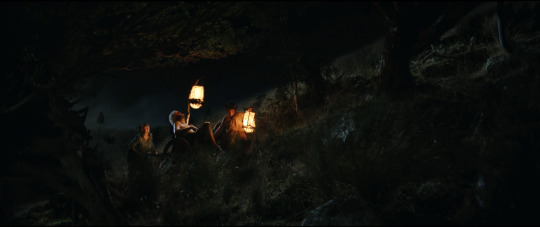
View On WordPress
#2022#3 stars#acteurlover#adrift#episode 2#j.a bayona#j.r.r tolkien#john d. payne#morfydd clark#patrick mckay#prime#review#Rings of Power#robert amaryo#season 1#tv-show
0 notes
Text
At SDCC showrunner John D. Payne said: “So, one, always back to Tolkien. And two, when Tolkien was silent, we tried to invent as Tolkienian a way as possible." Let's see how much of this is true...
Analysis of Amazon's "The Rings of Power"
Episode 1
Galadriel is on a quest for revenge, Gil-galad ships inconvenient people into the West, and a guy falls as a meteor out of the sky?
Let's see which parts of Tolkien's worldbuilding was used by the show, where they directly contradict what Tolkien wrote about his characters, and how much of the storyline is an Amazon invention (spoiler: all of it).
Spoiler warnings for the first episode.
Preface
I wanted to write a comprehensive overview about where Amazon's show actually adapted something from Tolkien's writing in their first episode, where they contradict Tolkien's writings, and where Amazon came up with their own inventions.
What I won't get into in this analysis is
most of the visual choices of the show. The series is a visual medium, while most of Tolkien's work isn't. Therefore I won't focus on visual differences unless a) Tolkien described something explicitly or b) it is relevant for the story, character or world building.
themes within Amazon's series or Tolkien's story. The interpretation of themes is heavily subjective, as is the assessment whether it was well integrated in the series or not. In addition, it can't be checked on an episode-to-episode basis and should be evaluated rather at the end of the season.
On a side note: I am aware that the show did not have the rights to all of Tolkien's work, but it still is their decision to either not read or consciously contradict his writings.
If I have overlooked anything in this episode, please let me know.
I'll add it with credit to the list.
Worldbuilding
Where the show references Tolkien
Locations
Tolkien's map is included, although with extensions made by the show.
Locations with the names Lindon, Rhovanion, Forodwaith and Valinor are shown.
Forodwaith is shown as a region of mostly ice and snow.
In Valinor, the Two Trees and a large city are briefly shown.
The destruction of the Two Trees is briefly shown and mentioned.
Races
The races of Elves, Dwarves, Men, Hobbits, Orcs and Trolls exist.
The Elves are immortal and have pointy ears.
The Hobbits are smaller than Men or Elves.
The concept of Elves sailing form Middle-earth to Valinor exists.
History
Elves journying from Valinor to Middle-earth is mentioned.
"The war" – probably refering to the war against Morgoth in general – is briefly shown with a few images and mentioned. Finrod is briefly shown fighting in a battle against Orcs. Morgoth's defeat is mentioned.
Somen Men have sides with Morgoth in the wars ages ago.
Language
Some of Tolkien's Quenya words and grammer are used in dialogue.
Tengwar letters and Cirth runes are used on some objects and in some places.
Where the show contradicts Tolkien
Elvish character design:
Age: Some Elves, like Celebrimbor and Gil-galad, look visibly too old. tolkien described his Elves either as youthful or as ageless in his writings, they are never supposed to look like middle-aged/older people.
Hair: The Amazon series shows most of the male Elves with short hair. However, whenever Tolkien describes the hair length of an Elf, it's long. For the Noldor and the Teleri as a whole the hair was described as long at one point.
Beauty: All of Tolkien's Elves are described as exceptionally beautiful. In Amazon's series this is not the case.
History:
The Prologue claims that it was Morgoth who "destroyed the very light of [the Elves'] home", but in Tolkien's story this was done by Ungoliant.
The Prologue also implies that the Elves went to war against Morgoth because of the destruction of the Two Trees, but in Tolkien's writings the Noldor rather left to avenge Finwë's death and the theft of the Silmarils.
Another implication of the Prologue seems to be that the Noldor never had been in Middle-earth before – or that there were no Elves in Middle-earth before their journey altogether.
No word for death: In the Amazon series, Galadriel in the intro says that they had no word for death yet. In Tolkien's writings however, at the time of Galadriel's childhood the Elves had already experienced death a) in Middle-earth during the Great Journey and b) in Valinor when Míriel died. Galadriel wouldn't have been born if Míriel hadn't died, because otherwise Finwë wouldn't have married Indis. The concept of death therefore must have existed.
Who is allowed to sail west: In the Amazon series, Gil-galad seems to decide which Elves are sailing West and which don't. This is heavily contradicting Tolkien's writings, where sailing West was open for all Elves – with the possible exception of the former leaders of the Noldorin rebellion, including Galadriel. This permission or ban came from the Valar, and not from any single elf, king of no king.
Sailing to Valinor: During the 2nd Age, the passage to Valinor over the sea was, more or less, a "normal" journey on ship. No special magic was needed to get there, and in fact sailors would reach Tol Eressëa first.
Elvish supervision of Mannish villages: The Silvan Elves in Amazon's Middle-earth seem to be ruled by Gil-galad and keep watch on human settlements east of the Ash mountains. In Tolkien's writings, Gil-galad ruled in Linon and at best over Eriador in general, but certainly not further east or south, were the Silvan Elves lived. The Silvan Elves kept to themselves and refused the rule of the Noldor, except for Galadirel in Lóthlorien in the 3rd Age. There is no record of any Mannish settlement being controlled by Elves against their will.
Meteor Man: It is impossible for any Man or Elf to fall down as a meteor and survive. However, for the few Maiar that came to Midde-earth no such incident was ever reported either: Sauron was already in Middle-earth in the 2nd Age, and the Istari came by ship.
Nori's name: Nori's full name is Elanor Brandyfoot. Elanor is a Sindarin name, and therefore an unlikely name for any Hobbit (or "proto-Hobbit") unless they had contact with Sindarin speaking Elves. However, this contact with the Sindar is unlikely to have happened in the Wilderlands east of the Anduin.
Language:
In Tolkien's 2nd Age, Westron did not exist yet. Elves and Men had trouble with communication. In Amazon's 2nd Age, everyone seems to speak the same language: Elves, Men and Harfoots. If they speak different languages, it is not made clear.
Elves are shown to speak English, but every now and then they switch to Quenya. However, it does not appear that their "English" is supposed to be Sindarin, because when Elrond writes Gil-galad's speech it's in Quenya, yet later Gil-galad gives the speech in English. Unless Elrond translated the speech into Sindarin afterwards the switch between Enlish and Quenya makes no sense.
Where the show invents their own content
Tirharad: The culture, history and current situation of Tirharad and its population is an invention of the show.
Harfoot-Hobbits in the Wilderlands: The culture, lifestyle and current situation of the Harfoot-Hobbits is an invention of the show.
Elvish culture:
Veiled Elf-women are nowere described in Tolkien's writings and an invention of the show.
The Greek/Roman-looking wreath is an invention of the show.
Elves calling healers "artificers", and they "labor [...] to render hidden truths as works of beauty" in order to heal the soul is an invention of the show.
Characters
Where the show references Tolkien
Galadriel: A character with the name Galadriel exists, who lived in Valinor for a while, has an older brother (named Finrod in the credits) and who has some connection to Gil-galad and Elrond. She has long, golden hair.
Elrond: A character with the name Elrond exists. He spends time in Lindon and has connections to Gil-galad and Galadriel.
Gil-galad: A character with the name Gil-galad exists. He is High King of the Noldor and has connections to Galadriel, Elrond and Celebrimbor.
Celebrimbor: A character with the name Celebrimbor exists. He is known as a great smith and has connections to Gil-galad.
Finrod: Galadriel's older brother (named "Finrod" only in the credits) exists. He is shown in the introduction, but is no longer alive in the present time of the show.
Sauron: A character with the name Sauron is briefly shown, and described as a servant of Morgoth, as a sourcerer and leader of armies of Orcs.
Morgoth: A character with the name Morgoth existed, and is described as the Great Foe. He is only mentioned, not shown.
Where the show contradicts Tolkien
Galadriel:
Amazon's Galadriel doesn't seem to have a husband nor a daughter. In contrast, in Tolkien's writings she gets married to Celeborn soon after the 2nd Age begins, and not long after gives birth to their daughter Celebrian.
Amazon's Galadriel has apparently spent a whole age (however long) searching for Sauron. In Tolkien's writings, Galadriel resists Sauron once she is aware of his presence, but there is no record of her actively searching for him anywhere or trying to take revenge.
Amazon's Galadriel is shown sailing West, although she stops and turns around. In contrast, Tolkien's Galadriel was "the last survivor of the princes and queens who had led the revolting Noldor to exile in Middle-earth. After the overthrow of Morgoth ath the end of the First Age a ban was set upon her return, and she had replied proudly that she had no wish to do so."
Elrond:
Amazon's Elrond has light brown hair and is rather young. Tolkien describes Elrond's hair as "dark as the shadows of twilight", and at the forging of the One Ring Elrond is already over 1600 years old, and at the Downfall of Númenor even over 3000 years old.
Amazon's Elrond is not considered an Elf-lord. Given that Tolkien's Elrond is the son of Eärendil, grandson of Dior and also great-grandson of Turgon, there is no way he would not be counted among the nobility or even royalty of any Eldar society he wanders into.
Gil-galad
Amazon's Gil-galad looks older than Galadriel, although in Tolkien's writings he is from a generation younger than Galadriel, and therefore most likely younger than her.
Amazon's Gil-galad refuses to acknowledge Sauron's presence in Middle-earth. In Tolkien's writings, Gil-galad is among the first to notice Sauron's shadow, to recognise it as a threat, and to try to form alliances against it.
Amazon's Gil-galad is dressed all in gold, including gold stars. In Tolkien's writing, he is instead associated with silver and white stars.
Celebrimbor
Amazon's Celebrimbor looks too old (see above).
Galadriel's brother (Finrod)
Amazon's Finrod is killed by Sauron, after having been on a hunt for Sauron. This heavily contradicts Tolkien's writings, where Finrod was supporting his friend Beren on a mission and is killed by a wolf in Sauron's dungeon.
Amazon's Finrod seems to have a very different philosphy compared to how Tolkien has written him. In Amazon's series, when a young Galadriel asks him how to differenciate between light and darkness, Finrod's advice response is that "sometimes we cannot know until we have touched the darkness". This seems contrary to any attitude that an Elf in Valinor before Morgoth's release would have, and especially strange for an Elf like Finrod, who had a very strong belief in Eru.
Sauron
Sauron in the series is said to have gained power after Morgoth's defeat, and that he found and killed Finrod. However, in Tolkien's writings he went into hiding until he appeared in fair form at the doorstep of the Elves. Finrod was killed by Sauron's wolf before Morgoth's defeat.
Where the show invented their own content
Galadriel: Galadriel's desire for revenge, her position as a warrior in and leader of the Northern armies, the expedition to Forodwaith, the journey with the ship and the subsequent jump into the ocean are all inventions by the show. See also the contradictions.
Elrond: Elrond writing speeches for Gil-galad is an invention by the show, as is his conscious decision to ignore warnings of Sauron's presence. See also the contradictions.
Gil-galad: Gil-galad's plan to get Galariel out of the way by sending her to Valinor because she is inconvenient is an invention by the show. See also the contradictions.
All other characters not already mentioned in the character section are inventions of the show. This includes
in Lindon: Thondir
in Tirharad: Arondir, Bronwyn, Theo, Waldreg, Revion
in Rhovanion: Nori, Poppy, Sadoc, Marigold, Malva, Largo
... and naturally all the other characters in the background.
Storyline
All three storylines – Galadriel's, Arondir's and Nori's – are the show's invention and have no basis in Tolkien's writings.
Summary
Worldbuilding: The show only uses the basics for the setup of their world, but most of them can be found in many fantasy settings. When it comes to the details, the show often contradicts Tolkien.
Characters: Most of the characters are invented by the show. The characters that are inspired by Tolkien are very differently characterised in comparison to Tolkien's writings.
Storyline: All the storylines in this episode are invented by the show, they have no basis in Tolkien's writings.
#LOTR ROP#LOTR TROP#the Rings of Power#LOTR#LOTR on prime#Amazon LOTR#trop review#my posts#TROP spoilers
119 notes
·
View notes
Text
non-exhaustive list of sources that are imo especially interesting/thought-provoking, just really solid, or otherwise a personal favorite:
MISC
“Leaders and Martyrs: Codreanu, Mosley and José Antonio,” Stephen M. Cullen (1986)
“Bureaucratic Politics in Radical Military Regimes,” Gregory J. Kasza (1987)
A History of Fascism, 1914–1945, Stanley Payne (1996)
The Fascist Revolution: Toward a General Theory of Fascism, George L. Mosse (1999)
Fascism Outside Europe: The European Impulse against Domestic Conditions in the Diffusion of Global Fascism, ed. Stein U. Larsen (2001)
Ancient Religions, Modern Politics: The Islamic Case in Comparative Perspective, Michael Cook (2014)
MARXISM
“Crisis and the Way Out: The Rise of Fascism in Italy and Germany,” Mihály Vajda (1972)
“Austro-Marxist Interpretation of Fascism,” Gerhard Botz (1976)
“Fascism: some common misconceptions,” Noel Ignatin (1978)
“Gramsci’s Interpretation of Fascism,” Walter L. Adamson (1980)
ARGENTINA
“The Ideological Origins of Right and Left Nationalism in Argentina, 1930–43,” Alberto Spektorowski (1994)
“The Making of an Argentine Fascist. Leopoldo Lugones: From Revolutionary Left to Radical Nationalism,” Alberto Spektorowski (1996)
“Argentine Nacionalismo before Perón: The Case of the Alianza de la Juventud Nacionalista, 1937–c. 1943,” Marcus Klein (2001)
BRAZIL
“Tenentismo in the Brazilian Revolution of 1930,” John D. Wirth (1964)
“Ação Integralista Brasileira: Fascism in Brazil, 1932–1938,” Stanley E. Hilton (1972)
“Integralism and the Brazilian Catholic Church,” Margaret Todaro Williams (1974)
“Ideology and Diplomacy: Italian Fascism and Brazil (1935–1938),” Ricardo Silva Seitenfus (1984)
“The corporatist thought in Miguel Reale: readings of Italian fascism in Brazilian integralismo,” João Fábio Bertonha (2013)
CHILE
“Corporatism and Functionalism in Modern Chilean Politics,” Paul W. Drake (1978)
“Nationalist Movements and Fascist Ideology in Chile,” Jean Grugel (1985)
“A Case of Non-European Fascism: Chilean National Socialism in the 1930s,” Mario Sznajder (1993)
CHINA
Revolutionary Nativism: Fascism and Culture in China, 1925–1937, Maggie Clinton (2017)
CROATIA
“An Authoritarian Parliament: The Croatian State Sabor of 1942,” Yeshayahu Jelinek (1980)
“The End of “Historical-Ideological Bedazzlement”: Cold War Politics and Émigré Croatian Separatist Violence, 1950–1980,” Mate Nikola Tokić (2012)
EGYPT
“An Interpretation of Nasserism,” Willard Range (1959)
Egypt’s Young Rebels: “Young Egypt,” 1933–1952, James P. Jankowski (1975)
“The Use of the Pharaonic Past in Modern Egyptian Nationalism,” Michael Wood (1998)
FRANCE
“Mores, “The First National Socialist”,” Robert F. Byrnes (1950)
“The Political Transition of Jacques Doriot,” Gilbert D. Allardyce (1966)
“National Socialism and Antisemitism: The Case of Maurice Barrès,” Zeev Sternhell (1973)
“Georges Valois and the Faisceau: The Making and Breaking of a Fascist,” Jules Levey (1973)
“The Condottieri of the Collaboration: Mouvement Social Révolutionnaire,” Bertram M. Gordon (1975)
“Myth and Violence: The Fascism of Julius Evola and Alain de Benoist,” Thomas Sheehan (1981)
GERMANY
“A German Racial Revolution?” Milan L. Hauner (1984)
“Abortion and Eugenics in Nazi Germany,” Henry P. David, Jochen Fleischhacker, and Charlotte Höhn (1988)
“Nietzschean Socialism — Left and Right, 1890–1933,” Steven E. Aschheim (1988)
The Brown Plague: Travels in Late Weimar and Early Nazi Germany, Daniel Guérin, tr. Robert Schwartzwald (1994)
“Hitler and the Uniqueness of Nazism,” Ian Kershaw (2004)
HAITI
“Ideology and Political Protest in Haiti, 1930–1946,” David Nicholls (1974)
“Michel-Rolph Trouillot’s State Against Nation: A Critique of the Totalitarian Paradigm,” Robert Fatton, Jr. (2013)
IRAN
“Iran’s Islamic Revolution in Comparative Perspective,” Said Amir Arjomand (1986)
IRAQ
“Arab-Kurdish Rivalries in Iraq,” Lettie M. Wenner (1963)
“From Paper State to Caliphate: The Ideology of the Islamic State,” Cole Bunzel (2015)
“Iraqi Archives and the Failure of Saddam’s Worldview in 2003,” Samuel Helfont (2023)
ISRAEL
“The Emergence of the Israeli Radical Right,” Ehud Sprinzak (1989)
“Max Nordau, Liberalism and the New Jew,” George L. Mosse (1992)
The Stern Gang: Ideology, Politics and Terror, 1940–1949, Joseph Heller (1995)
““Hebrew” Culture: The Shared Foundations of Ratosh’s Ideology and Poetry,” Elliott Rabin (1999)
“Israel’s fascist sideshow takes center stage,” Natasha Roth-Rowland (2019)
“‘Frightening proportions’: On Meir Kahane’s assimilation doctrine,” Erik Magnusson (2021)
ITALY
“The Fascist Conception of Law,” H. Arthur Steiner (1936)
“The Goals of Italian Fascism,” Edward R. Tannenbaum (1969)
“Fascist Modernization in Italy: Traditional or Revolutionary?” Roland Sarti (1970)
“Fascism as Political Religion,” Emilio Gentile (1990)
“I redentori della vittoria: On Fiume’s Place in the Genealogy of Fascism,” Hans Ulrich Gumbrecht (1996)
JAPAN
“A New Look at the Problem of “Japanese Fascism”,” George M. Wilson (1968)
“Marxism and National Socialism in Taishō Japan: The Thought of Takabatake Motoyuki,” Germaine A. Hoston (1984)
“Fascism from Below? A Comparative Perspective on the Japanese Right, 1931–1936,” Gregory J. Kasza (1984)
“Japan’s Wartime Labor Policy: A Search for Method,” Ernest J. Notar (1985)
“Fascism from Above? Japan’s Kakushin Right in Comparative Perspective,” Gregory J. Kasza (2001)
PARAGUAY
“Political Aspects of the Paraguayan Revolution, 1936–1940,” Harris Gaylord Warren (1950)
“Toward a Weberian Characterization of the Stroessner Regime in Paraguay (1954–1989),” Marcial Antonio Riquelme (1994)
ROMANIA
“The Men of the Archangel,” Eugen Weber (1966)
“Breaking the Teeth of Time: Mythical Time and the “Terror of History” in the Rhetoric of the Legionary Movement in Interwar Romania,” Raul Carstocea (2015)
RUSSIA
“Was There a Russian Fascism? The Union of Russian People,” Hans Rogger (1964)
“The All-Russian Fascist Party,” Erwin Oberländer (1966)
“The Zhirinovsky Threat,” Jacob W. Kipp (1994)
Russian Fascism: Traditions, Tendencies, Movements, Stephen Shenfield (2000)
“Why fascists took over the Reichstag but have not captured the Kremlin: a comparison of Weimar Germany and post-Soviet Russia,” Steffen Kailitz and Andreas Umland (2017)
SLOVAKIA
“Storm-troopers in Slovakia: the Rodobrana and the Hlinka Guard,” Yeshayahu Jelinek (1971)
SPAIN
“The Forgotten Falangist: Ernesto Gimenez Cabellero,” Douglas W. Foard (1975)
Fascism in Spain, 1923–1977, Stanley Payne (1999)
“Spanish Fascism as a Political Religion (1931–1941),” Zira Box and Ismael Saz (2011)
SYRIA
The Ba‘th and the Creation of Modern Syria, David Roberts (1987)
TURKEY
“Kemalist Authoritarianism and fascist Trends in Turkey during the Interwar Period,” Fikret Adanïr (2001)
“The Other From Within: Pan-Turkist Mythmaking and the Expulsion of the Turkish Left,” Gregory A. Burris (2007)
“The Racist Critics of Atatürk and Kemalism, from the 1930s to the 1960s,” İlker Aytürk (2011)
UNITED KINGDOM
“Northern Ireland and British fascism in the inter-war years,” James Loughlin (1995)
“‘What’s the Big Idea?’: Oswald Mosley, the British Union of Fascists and Generic Fascism,” Gary Love (2007)
“Why Fascism? Sir Oswald Mosley and the Conception of the British Union of Fascists,” Matthew Worley (2011)
UNITED STATES
“Ezra Pound and American Fascism,” Victor C. Ferkiss (1955)
“Populist Influences on American Fascism,” Victor C. Ferkiss (1957)
“Vigilante Fascism: The Black Legion as an American Hybrid,” Peter H. Amann (1983)
“Silver Shirts in the Northwest: Politics, Personalities, and Prophecies in the 1930s,” Eckard V. Toy, Jr. (1989)
“Women in the 1920s’ Ku Klux Klan Movement,” Kathleen M. Blee (1991)
“‘Leaderless Resistance’,” Jeffrey Kaplan (1997)
“The post-war paths of occult national socialism: from Rockwell and Madole to Manson,” Jeffrey Kaplan (2001)
“The Upward Path: Palingenesis, Political Religion and the National Alliance,” Martin Durham (2004)
“The F Word: Is Donald Trump a fascist?” Dylan Matthews (2021)
“Castizo Futurism and the Contradictions of Multiracial White Nationalism,” Ben Lorber and Natalie Li (2022)
#this is not The Masterpost this has just emerged along the way#and there's definitely plenty that could go here that aren't bc i just got tired of listing them#i need somewhere and preferably multiple places to put sources so i feel like ive accomplished something when i finish reading them lol
11 notes
·
View notes